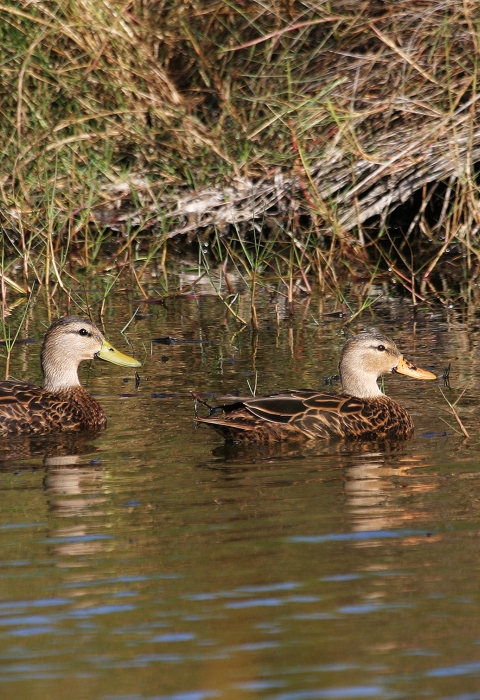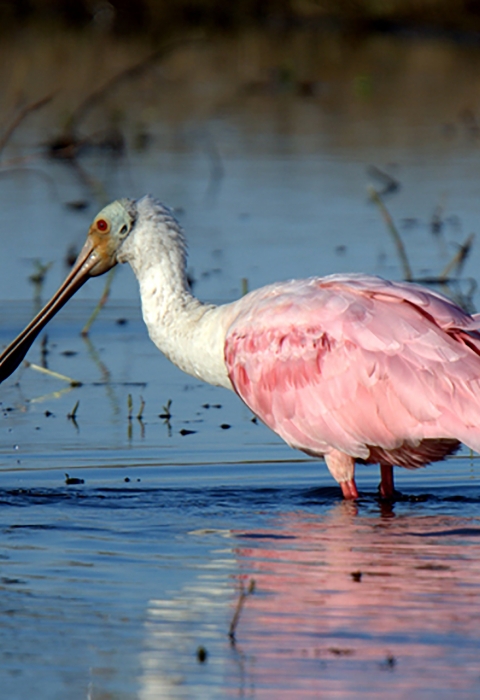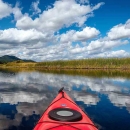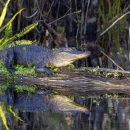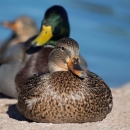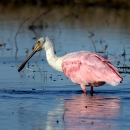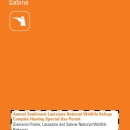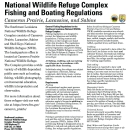The Sabine National Wildlife Refuge West Cove North Recreation Area will temporarily close to the public May 1 – June 15, 2024. This closure includes the parking lot, the walking trail, the recreational area, and associated facilities. The closure is required to ensure public safety while the area serves as a staging location and launch site to construct and restore oyster reef habitat along the West Cove shoreline of Sabine National Wildlife Refuge (NWR). Sabine NWR’s West Cove North and South and Hog Island Gully Recreation Areas, parking lots, and boat launches will remain open.
The Nature Conservancy, in collaboration with the U.S Fish and Wildlife Service, is completing an important oyster reef restoration and coastal shoreline protection project. The project is located in West Cove of Calcasieu Lake along the shoreline of Sabine NWR. This phase of the project will add an additional 1 mile section of oyster reef to those created in 2017, 2021, and 2022. The past phases of the project have successfully grown into a functioning nearshore oyster reef. The reef is made of gabion baskets filled with limestone which are placed in the water near the shore. Reefs create habitat for many marine species including fish, shrimp, and crabs, and provide oyster larvae to the adjacent public oyster seed ground. The oyster reef also protects and stabilizes the coastal marshes of Sabine NWR by slowing wave energy and acting as an important coastal buffer. Finally, this project provides a natural protective barrier to vulnerable portions of Louisiana Hwy 27.
This project provides many benefits to the people and communities of Southwest Louisiana, as well as to the wildlife and habitat of Sabine National Wildlife Refuge and Calcasieu Lake. Refuge staff asks that visitors be patient and obey area closures throughout the project. For additional information regarding this project, Sabine NWR, or other Southwest Louisiana National Wildlife Refuges, please call 337-774-5923 or 337-563-7684 or email us at SWLRComplex@fws.gov
The Commercial Fishing Guide application period closed on February 28, 2024. A second application period will take place from July 1 - July 31, 2024. For more information or to apply please email swlrcomplex@fws.gov
Sabine National Wildlife Refuge: Closure of Hog Island Gully Recreation Area South Extended, Closure of Hog Island Gully Recreation Area North Announced.
Sabine National Wildlife Refuge (NWR) Hog Island Gully Recreation Area South, including both boat launches, will remain closed until May 15, 2024. Additionally, the Hog Island Gully Recreation Area North will be closed to all public use from February 15, 2024 until May 15, 2024. These closures are necessary for completion of two U.S. Army Corps of Engineers (USACE) projects:
1) Louisiana Coastal Area Beneficial Use of Dredged Material (LCA BUDMAT Program): Calcasieu/Sabine Project. More information can be found at: https://www.mvn.usace.army.mil/About/Offices/Operations/Beneficial-Use-…
2) Coastal Wetland Planning, Protection, and Restoration Act (CWPPRA): Long Point Bayou Marsh Creation Project (CS-85) (designed by Coastal Protection and Restoration Authority of Louisiana (CPRA) and constructed by USACE). More information can be found at: https://www.lacoast.gov/reports/gpfs/CS-85.pdf
These projects require the complete closures of Hog Island Gully Recreation Area South, including both boat launches, as well as Hog Island Gully Recreation Area North, due to public safety concerns and project/personnel logistics. An updated closure timeline will be given as project status evolves.
Refuge staff asks that visitors please be patient and obey area closures for the duration of the project period. For additional information regarding this closure, Sabine NWR, or other Southwest Louisiana NWRs, please call 337-762-3816 or contact us at SWLRComplex@fws.gov.
Visit Us
Located approximately 26 miles south of Sulphur, Louisiana, Sabine National Wildlife Refuge has numerous recreation areas where you can fish, crab or take a hike. Whether you are looking for an alligator to photograph or just a place to stretch your legs, the Wetland Walkway is always an adventure.
Learn more about our hunting regulations here: Southwest Louisiana Hunting Regulations
Learn more about our fishing and boating regulations here: Southwest Louisiana Fishing and Boating Regulations
Location and Contact Information
Tours
Auto tour
Beginning about 26 miles south of Sulphur, Louisiana on State Highway 27 South, Sabine NWR includes several recreational areas accessible by car. Be sure to observe local traffic signs and laws, posted closures, and prohibited activities.
The refuge and its roadside recreation areas may be accessed via automobile year round, from dawn until dusk, excluding posted closures
What We Do
Wildlife conservation is at the heart of the National Wildlife Refuge System. It drives everything on U.S. Fish and Wildlife Service lands and waters managed within the Refuge System, from the purposes for which a national wildlife refuge national wildlife refuge
A national wildlife refuge is typically a contiguous area of land and water managed by the U.S. Fish and Wildlife Service for the conservation and, where appropriate, restoration of fish, wildlife and plant resources and their habitats for the benefit of present and future generations of Americans.
Learn more about national wildlife refuge is established to the recreational activities offered to the resource management tools used. Using conservation best practices, the Refuge System manages Service lands and waters to help ensure the survival of native wildlife species.
Our Organization
Our Species
The refuge was created with the primary goal of providing habitat and breeding grounds for migratory birds and waterfowl. The estuarine systems found in the refuge also provide habitat for a highly diverse community of other wildlife including several species of native fish, crustaceans, mollusks, amphibians, reptiles, and birds.
Our Library
Publications, photos and more that could be of interest to you about the refuge.
Get Involved
Discover for yourself what tens of thousands of volunteers have learned: Volunteering for the U.S. Fish and Wildlife Service is fun and rewarding in many ways. Master new skills. Meet new friends. Enjoy a sense of accomplishment from doing your part to further wildlife conservation for the pleasure of generations to follow. Check out our station's latest volunteer opportunities on volunteer.gov
Volunteers and student interns provide much needed assistance with refuge programs. They are often able to complete work that the refuge staff would be unable to do. The hours, work assignments, and more are tailored to meet the needs of both the refuge and the volunteer or intern.
Nature does not recognize human-made boundaries. In order to conserve our natural and cultural resources effectively, we must work with others to bridge these boundaries. Partnerships foster creative solutions to challenging situations and often the results are greater than the sum of the parts. Learn more about our local partners.
Partnerships are very important to help the refuge achieve its goals, objectives, and strategies, leverage funds, minimize costs, and bridge relationships with others.
Youth Programs open the door to a potentially life-changing experience. If you land a student internship, a fellowship or a volunteer opportunity at a national wildlife refuge national wildlife refuge
A national wildlife refuge is typically a contiguous area of land and water managed by the U.S. Fish and Wildlife Service for the conservation and, where appropriate, restoration of fish, wildlife and plant resources and their habitats for the benefit of present and future generations of Americans.
Learn more about national wildlife refuge , fish hatchery or other Fish and Wildlife Service site, you’re bound to come away with new insights and excitement about conservation.
